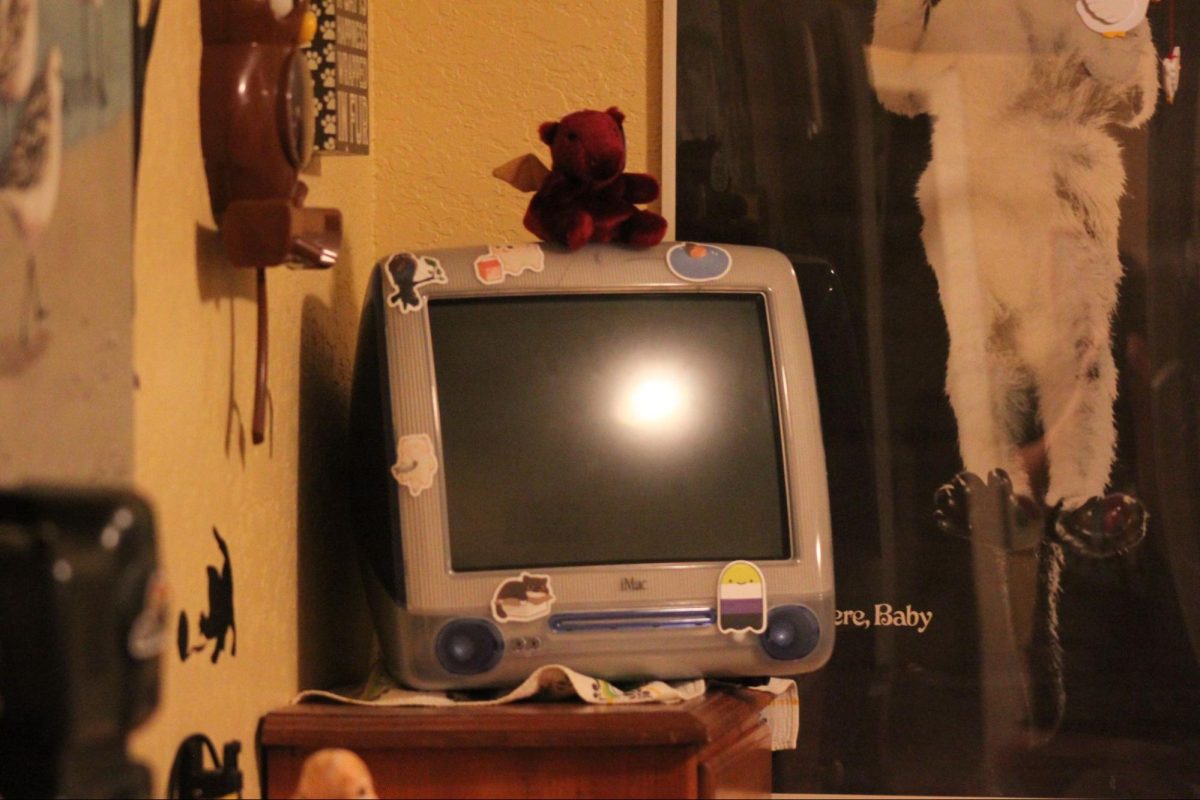Black Lives Matter.
June 19, 2020
People scream in the streets, their voices hoarse as they cry for justice. They march protesting the murder of innocents. Fires flare, windows shatter, and an acrid chemical smell fills the air. People fall gasping for breath, tears filling their eyes, their words snatched out of their throats. Police swarm, dressed for war against the very people they are meant to protect, the very people they have failed. They fall upon the protesters, herding them into a bristling mass. Then it rains. Rubber bullets fly through the air, pepper spray and tear gas are sprayed indiscriminately, and a different sort of scream fills the air. People clutch their chests and rub at their eyes, writhing as bruises and chemical burns form on their skin. Pain radiates like a suffocating smog.
________________________________________
It seems that every other day we hear the news of an innocent Black man or woman arrested, beaten, or murdered. Sometimes horrific events such as these don’t even make the news. The sad fact is that for many in the Black community, police brutality is another fact of life. In our interviews each student expressed concerns for their family members, “I just worry for them in everyday life at a time like this”, says Jackson Young (‘22). How is it that Black people only make up 13.4% of the American population and yet they are at risk of being brutalized or murdered by police at two and a half times the rate of white people, who make up 76.5% of the population (US Census Bureau).
Pew Research Center finds that over 65% of Black adults “say they’ve been in situations where people acted as if they were suspicious of them because of their race or ethnicity, while only a quarter of white adults say that’s happened to them.” Black people are also five times as likely to get stopped by the police because of their race or ethnicity than white people. A report by the Bureau of Justice Statistics states that, as of 2018, there were 1,501 Black prisoners per 100,000 Black adults. The number for white prisoners is much lower, with around 268 white prisoners for every 100,000 white adults. The National Registry of Exonerations records 2,625 exonerations that have taken place since 1989, 1,295 of them being Black people. While this statistic doesn’t include the innocents who are still imprisoned, the gap in exonerees shows the extent to which the criminal justice system disproportionately prosecutes Black people. Furthermore, according to mappingpoliceviolence.org, the police killed 1,099 people in 2019, 24% of which were Black people.
Of these killings, only 4% of the officers who committed them were charged and only 1% convicted. Sanaa Brown (‘22) says,“It hurts, you know, to see people murdered. It hurts the most to see people trying to justify the murders . . . I’m sick of seeing cops abuse their power . . . We want justice, we want cops to be held accountable.” Sadly, there is no accountability for law enforcement in our legal system. Police are protected by unions, and in many states, special sets of laws. Police unions hold massive political and legal power, with the ability to negotiate contracts and pressure policymakers in their favor. Contracts negotiated by unions can grant officers many privileges. According to professor Seth Stoughton, union contracts, “may limit how officers are investigated… how officers are disciplined, it may require that an officer’s disciplinary records be cleared every 60 days.” This means that, “there is no history even when an officer is engaged in misconduct repeatedly.”
In some states police also operate under special sets of laws called the Law Enforcement Officers’ Bill of Rights. These laws allow officers special powers if they are ever put on trial, such as prior access to all evidence that may be used against them as well, ability to justify any misconduct in their files, and special interrogation privileges. With laws like these on the off chance an officer is charged, it is extremely unlikely they will be convicted.
There is also the issue of qualified immunity. This rule states that a cop cannot be sued unless they have violated a rule clearly established, a qualifier that is highly subjective. Moreover, a right is not considered clearly established until a cop has previously been punished for violating it. This circular logic further protects officers from retribution for their misconduct. Thus the system allows thousands of deaths year after year with little to no consequence.
________________________________________
Though explicit racial biases aren’t as common and are considered taboo, implicit biases still exist in the minds of many, if not all of us. Implicit biases, as defined by the National Initiative for Building Community Trust and Justice (NIBCTJ), are “the automatic association people make between groups of people and stereotypes about those groups.” Implicit biases can exist for a range of groups, from gender, to culture, to nationality. In policing, implicit racial biases are the cause of many instances of profiling, arrest, assault, and murder. Many cops may act on their implicit biases instead of relying on facts and training. NIBCTJ states that “studies suggest that implicit bias contributes to “shooter bias,”—the tendency for police to shoot unarmed black suspects more often than white ones—as well as the frequency of police stops for members of minority groups.” While such implicit racial biases are widely pervasive and ultimately subliminal, various forms of training can help people, especially police officers, rid themselves of these biases. Kirwan Institute for the Study of Race and Ethnicity writes that “Implicit biases are malleable. Our brains are incredibly complex, and the implicit associations that we have formed can be gradually unlearned through a variety of debiasing techniques.”
Aside from implicit bias, the quality and amount of training a police officer undergoes also comes into question concerning the many assaults and murders of Black people under police custody. The Bureau of Justice Statistics states that the standard police training program is 840 hours or 21 weeks. While the police force in America is one of the best trained in the world, as an article in The Atlantic by Seth Stoughton explains, it is what they are trained to do that is part of the problem. Stoughton says that “officers are trained to shoot before a threat is fully realized, to not wait until the last minute because the last minute may be too late.” This avoidance of hesitancy may have been behind the 259 killings of Black people by the police in 2019 alone, as recorded by mappingpoliceviolence.org.
The majority of police training consists of learning state law, first-aid, arms training, and combat, among other things, it seems that not much room is left for de-escalation training. A 2017 survey by Pew Research Center finds that “one-in four officers say that they have had no training on how to de-escalate a situation in the past year.” In addition, as of 2017, only 21 states mandate de-escalation training, reports American Public Media, and typical training requires only two hours per year. That means that more than half of the country doesn’t mandate de-escalation training, and those that do require a miniscule amount. De-escalation training teaches police officers how to use different communication strategies to defuse and de-escalate potentially dangerous situations, whether it be someone experiencing a mental crisis or someone who could be armed. Without adequate training, police officers are not equipped to handle certain situations and are forced to rely on instinct, personal biases, and “no-hesitancy” training, leading to many wrongful and brutal deaths of innocent people.
________________________________________
Sparked by the horrific muder of George Floyd, the protests that have taken the country by storm all started on May 26th in Minneapolis. And as of the publication of this article, they are still going on. While a handful of rioters and looters ravage the country’s cities and storefronts, thousands of peaceful protesters march through the streets, demanding reforms and justice for those lost. These peaceful protests not only take place in America but all over the world. The massive outcry has led to an abundance of petitions, increased awareness, and pushes for change.
Among the many phrases cried out during protests, “defund the police” is a popular one. “Defund the police” does NOT mean getting rid of the police but diverting funds for the police and other law enforcement entities. These funds would then be reinvested back into areas that lack funding, like education, housing, health, and other public services. The US spent $14 billion on federal law enforcement in 2019, while it only spent $254 million on the entire Department of Health according to information from White House press releases. Defunding the police would lower budgets of police departments and use that money to help resolve issues like poverty, homelessness, addiction, and mental illness. Thus addressing the root cause of higher rates of crime in the first place. Funds could also be allocated to specialized groups with the ability to handle specific cases, such as domestic violence.
After two weeks of protesting, legislators are proposing new policy reforms and acts. Notably, the Justice in Policing Act which was introduced by Congress Democrats on June 8th. “The Justice in Policing Act would: 1) establish a national standard for the operation of police departments; 2) mandate data collection on police encounters; 3) reprogram existing funds to invest in transformative community-based policing programs; and 4) streamline federal law to prosecute excessive force and establish independent prosecutors for police investigations” (judiciary.house.gov). Locally Governor Inslee has “suggested creating a new state agency to investigate in-custody deaths, making it state law for officers to report their colleagues’ misconduct, and restricting the use of chokeholds” says King 5 News. These new proposals for reforms are just a small part of the evidence that protesting and using your voice to speak out against injustice can lead to tangible results. With luck this unprecedented wave of public outrage and protest will not end soon, and with it will bring much needed change. Use your voice and your resources to help in the fight against injustice and oppression. Black lives matter.






